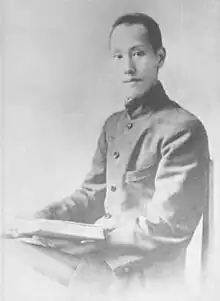
Pan Dawei (Chinese: 潘达微; 1881–1929)[1]: 120–1 was a Chinese artist and political radical.[2]
As a journalist, Pan was one of the first political cartoonists in China and a member of the Tongmenghui.[3] He worked with He Jianshi and others to create Journal of Current Pictorial, which published these cartoons.[4]: 226 They showed support for the 1911 Revolution against the Qing dynasty.[1]: 121
As an artist, he worked with Huang Banruo and Deng Erya to found the Hong Kong branch of the Guangdong Association for the Study of Chinese Paintings.[4]: 227 He worked in the art department of the Nanyang Brothers Tobacco Company, creating calendar advertisement posters.[1]: 121 He associated with several other poster artists, including Zhou Bosheng, Zheng Mantuo, Li Mubai, and Xie Zhiguang.[1]: 122
72 Martyrs
During the Second Guangzhou Uprising on 27 April 1911, Pan buried the 72 martyrs of the uprising on Red Flower Ridge (later renamed Yellow Flower Ridge).[5][6] He is buried in the Huanghuagang 72 Martyrs Cemetery in Guangzhou.[7]
References
- 1 2 3 4 Laing, Ellen Johnston (2004). Selling Happiness: Calendar Posters and Visual Culture in Early-Twentieth-Century Shanghai. University of Hawaii Press. ISBN 978-0-8248-2764-9. Retrieved 27 November 2019.
- ↑ Pittman, Don Alvin (2001). Toward a Modern Chinese Buddhism: Taixu's Reforms. University of Hawaii Press. p. 72. ISBN 978-0-8248-2231-6. Retrieved 27 November 2019.
- ↑ Lent, John A.; Ying, Xu (2017). Comics Art in China. Univ. Press of Mississippi. p. 13. ISBN 978-1-4968-1177-6. Retrieved 27 November 2019.
- 1 2 Andrews, Julia F.; Shen, Kuiyi (2012). The Art of Modern China. Univ of California Press. ISBN 978-0-520-23814-5. Retrieved 27 November 2019.
- ↑ Lu, Hanchao (2017). The Birth of a Republic. University of Washington Press. p. 19. ISBN 978-0-295-80690-7. Retrieved 27 November 2019.
- ↑ Poon, Shuk-wah (2011). Negotiating Religion in Modern China: State and Common People in Guangzhou, 1900-1937. Chinese University Press. p. 30. ISBN 978-962-996-421-4. Retrieved 27 November 2019.
- ↑ "KMT leader pays respect to martyrs". China Daily. 29 March 2005. Retrieved 27 November 2019.